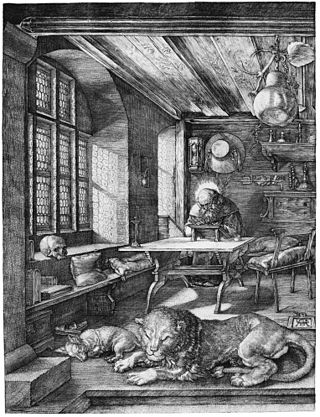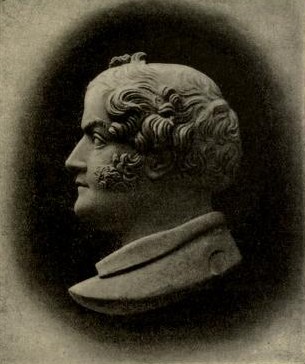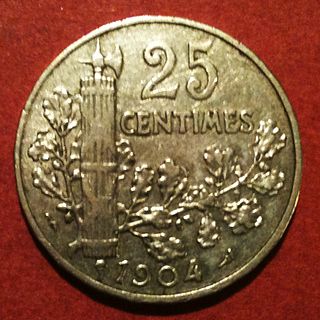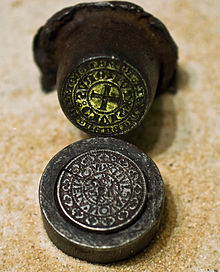
Engraving is the practice of incising a design onto a hard, usually flat surface by cutting grooves into it with a burin. The result may be a decorated object in itself, as when silver, gold, steel, or glass are engraved, or may provide an intaglio printing plate, of copper or another metal, for printing images on paper as prints or illustrations; these images are also called "engravings". Engraving is one of the oldest and most important techniques in printmaking.

Benedetto Pistrucci was an Italian gem-engraver, medallist and coin engraver, probably best known for his Saint George and the Dragon design for the British sovereign coin. Pistrucci was commissioned by the British government to create the large Waterloo Medal, a project which took him thirty years to complete.

A medal or medallion is a small portable artistic object, a thin disc, normally of metal, carrying a design, usually on both sides. They typically have a commemorative purpose of some kind, and many are presented as awards. They may be intended to be worn, suspended from clothing or jewellery in some way, although this has not always been the case. They may be struck like a coin by dies or die-cast in a mould.

Victor David Brenner was a Lithuanian sculptor, engraver, and medalist known primarily as the designer of the United States Lincoln Cent.

A plaquette is a small low relief sculpture in bronze or other materials. These were popular in the Italian Renaissance and later. They may be commemorative, but especially in the Renaissance and Mannerist periods were often made for purely decorative purposes, with often crowded scenes from religious, historical or mythological sources. Only one side is decorated, giving the main point of distinction with the artistic medal, where both sides are normally decorated. Most are rectangular or circular, but other shapes are found, as in the example illustrated. Typical sizes range from about two inches up to about seven across a side, or as the diameter, with the smaller end or middle of that range more common. They "typically fit within the hand", as Grove puts it. At the smaller end they overlap with medals, and at the larger they begin to be called plaques.
This glossary of numismatics is a list of definitions of terms and concepts relevant to numismatics and coin collecting, as well as sub-fields and related disciplines, with concise explanations for the beginner or professional.
Frank Gasparro was the tenth Chief Engraver of the United States Mint, holding this position from February 23, 1965, to January 16, 1981. Before that, he was Assistant Engraver. He designed both sides of the Susan B. Anthony dollar, both sides of the Eisenhower Dollar, the Lincoln Memorial reverse of the cent, and the reverse of the Kennedy half dollar.

John F. Flanagan was a sculptor who was widely known for his statuary and plaquettes but recognized foremost for his designs of coinage and commemorative medals. Among his best known designs are the obverse (front) and reverse of the United States quarter dollar featuring the profile of George Washington, a coin that has been in continuous circulation with some modifications since 1932.

A devotional medal is a medal issued for religious devotion.
John Roettiers was a celebrated English engraver and medallist.

Valerio Belli, also known as Valerio Vicentino, was a celebrated medallist, gem engraver, goldsmith, who with Giovanni Bernardi, who was twenty years younger, was the leading specialist in intaglios engraved in rock crystal, a difficult luxury form which Belli pioneered. These were highly sought after by wealthy Italian collectors. Though described as being "engraved", the intaglios are cut by drills, sometimes quite deeply, and developed their style from classical coins and engraved gems, to give "smoothly and eloquently orchestrated figural compositions". Castings of many of the crystal carvings were taken in wax and them used to make metal plaquettes, which Belli also designed and made de novo. He was described as a goldsmith, though no surviving works are known, and had some role at the Papal mint, though no coins are clearly attributable to him.
Nicholas Briot was an English coin engraver, medallist and mechanical engineer. Born in France, he emigrated to England and became chief engraver to the Royal Mint in 1633 and is credited with the invention of the coining-press.

Henri Auguste Jules Patey was a French sculptor, medallist and coin engraver.

James Barton Longacre was an American portraitist and engraver, and the fourth chief engraver of the United States Mint from 1844 until his death. Longacre is best known for designing the Indian Head cent, which entered commerce in 1859, and for the designs of the Shield nickel, Flying Eagle cent and other coins of the mid-19th century.

Louis-Eugène Mouchon was a French painter, graphic artist, medalist, engraver and sculptor. He created state papers, stamps, coins, currency and medals. He was the son and pupil of Louis Claude Mouchon, the painter. He exhibited at the Salon from 1876 onwards and became an Associate of the Artistes Francais in 1888. His most famous stamps are the Mouchon series and the Navigation & Commerce series of French postage stamps. His medals can be found in the collection of several museums.
Horst Hahne, is a German-born Australian sculptor, medallist and designer.

Mother coins, alternatively known as seed coins, matrix coins, or model coins (樣錢), were coins used during the early stages of the casting process to produce Chinese, Japanese, Korean, Ryukyuan, and Vietnamese cash coins. As cash coins were produced using sand casting mother coins were first produced to form the basis for all subsequent cash coins to be released into circulation. Under the Han dynasty in China mints started producing cash coins using bronze master moulds to solve inconsistencies in circulating coins, this only worked partially and by the sixth century mother coins were introduced to solve these inconsistencies almost completely. The Japanese adopted the usage of mother coins in the 600s and they were used to manufacture cast Japanese coins until the Meiji period. The mother coin was initially prepared by engraving a pattern with the legend of the cash coin which had to be manufactured. In the manufacturing process mother coins were used to impress the design in moulds which were made from easily worked metals such as tin and these moulds were then placed in a rectangular frame made from pear wood filled with fine wet sand, possibly mixed with clay, and enhanced with either charcoal or coal dust to allow for the molten metal to smoothly flow through, this frame would act as a layer that separates the two parts of the coin moulds. The mother coin was recovered by the people who cast the coins and was placed on top of the second frame and the aforementioned process was repeated until fifteen layers of moulds had formed based on this single mother coin. After cooling down a "coin tree" (錢樹) or long metallic stick with the freshly minted cash coins attached in the shape of "branches" would be extracted from the mould and these coins could be broken off and if necessary had their square holes chiseled clean, after this the coins were placed on a long metal rod to simultaneously remove the rough edges for hundreds of coins and then these cash coins could be strung together and enter circulation.

Christian Fueter was a Swiss medalist and mint-master at Bern from 1792–1837.
Pietro Paolo Troisi was a Maltese Baroque silversmith, sculptor, medallist, designer, engraver and Master of the Mint. His works include bronze sculptures of his patron António Manoel de Vilhena, designs of various coins and medals, a wide range of mainly religious works in silver, engraved portraits, designs for temporary triumphal arches and designs for works in a number of churches, most notably the altar of repose at the Mdina cathedral.

Italian Renaissance sculpture was an important part of the art of the Italian Renaissance, in the early stages arguably representing the leading edge. The example of Ancient Roman sculpture hung very heavily over it, both in terms of style and the uses to which sculpture was put. In complete contrast to painting, there were many surviving Roman sculptures around Italy, above all in Rome, and new ones were being excavated all the time, and keenly collected. Apart from a handful of major figures, especially Michelangelo and Donatello, it is today less well-known than Italian Renaissance painting, but this was not the case at the time.















